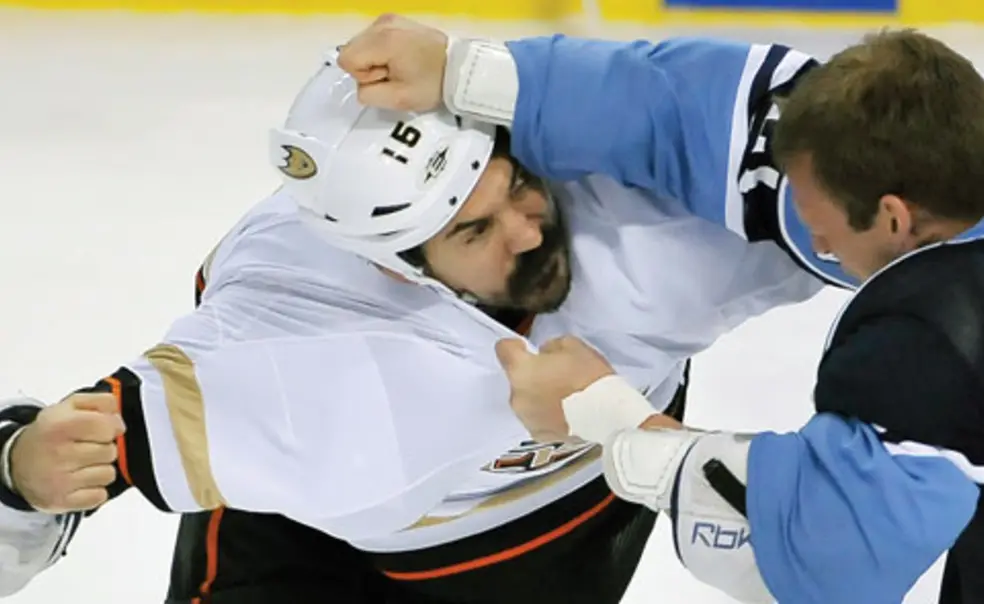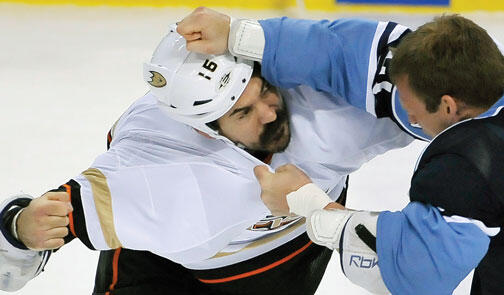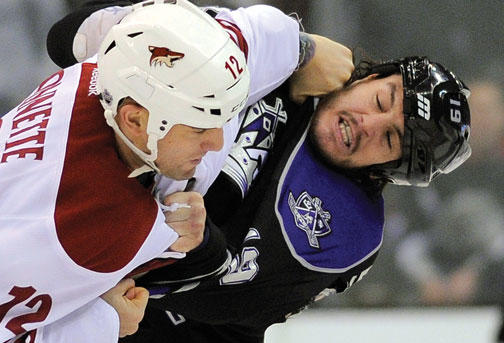EXTRA POINT: Another day at the ice fights for Princeton NHL players
I really ought to like professional hockey. It is a lightning-fast sport, requiring tremendous skill and stamina. But the fights that seem to break out in virtually every NHL game make me squirm with embarrassment. The New York Times’ three-part series on the life and death of hockey fighter Derek Boogaard revealed that hockey’s combatants may be prone to developing chronic traumatic encephalopathy (C.T.E.), a condition thought to be brought on by repeated blows to the head. That discovery is fueling a growing debate about the health dangers of hockey’s rampant fighting.
Two of the league’s most prominent fighters are Princeton graduates — Kevin Westgarth ’07 of the Los Angeles Kings and George Parros ’03 of the Anaheim Ducks. Last year Parros led the NHL in major penalties, while Westgarth was tied for 10th.
Westgarth, who is in his second full season in the league, sounded somber last September when asked what lessons he might take from Boogaard’s death. “I’ve been extremely lucky,” he admitted to the Los Angeles Times. “Inevitably it is our choice, and we all kind of know the deal.”
Parros is far from the typical hockey tough. While the rugged, 6-foot-5 player is famed around the league for his lumberjack’s mustache, he also is known for cutting his long hair in public every year to raise money for childhood leukemia. I wondered: Why would a bright 32-year-old risk chronic pain and possible dementia to smack some guys around in a hockey rink?
When I met Parros before a game against the New Jersey Devils, he was incredibly matter-of-fact about what he does.
“I saw an opportunity and I took it,” he told me. “I realized if I was going to make it to the NHL sooner rather than later, I knew that given my size, I’d probably have to start [fighting].”
Parros didn’t fight in college hockey, where it carries stiff penalties. In the pros, he told me, fights fire up a flat team — much like a baseball manager who gets himself thrown out of a game — and discourage dirty play. Using logic that seemed tortured, Parros claimed that fighting actually cuts down on violence in NHL games. Players are less likely to throw a punch or an elbow, this thinking goes, because if they do, enforcers — big guys who know how to fight — will respond. “If you eliminate fighting, you’re going to have more people making dangerous hits because there’s no consequence for them. They won’t have to face a player like me.”
Parros said he’s had just one concussion in his seven-year NHL career, but he does admit to chronic soreness in his hands, back, and shoulders. As for the dangers to his brain, he allowed that it is a risk, but one worth taking. “This C.T.E. they talk about, it’s not just from fighting. It’s from being in a high-intensity sport with all the collisions. It’s a risk you run, but we get to do what we love for a living.”
That part I can understand. Parros clearly is a thoughtful guy, and I liked him a lot. That’s why I sure hope he’s right about the gamble he and Westgarth seem to be taking.
Extra Point explores the people and issues in Princeton sports.
Merrell Noden ’78 is a former staff writer at Sports Illustrated and a frequent PAW contributor.















No responses yet